Hood insulator having an integral air box closeout feature
Overgaard , et al.
U.S. patent number 10,330,057 [Application Number 15/419,619] was granted by the patent office on 2019-06-25 for hood insulator having an integral air box closeout feature. This patent grant is currently assigned to Ford Global Technologies, LLC. The grantee listed for this patent is FORD GLOBAL TECHNOLOGIES, LLC. Invention is credited to Keith Brown, Bryn Arthur Davies, Martin Hagen, Neil Lawson Overgaard.
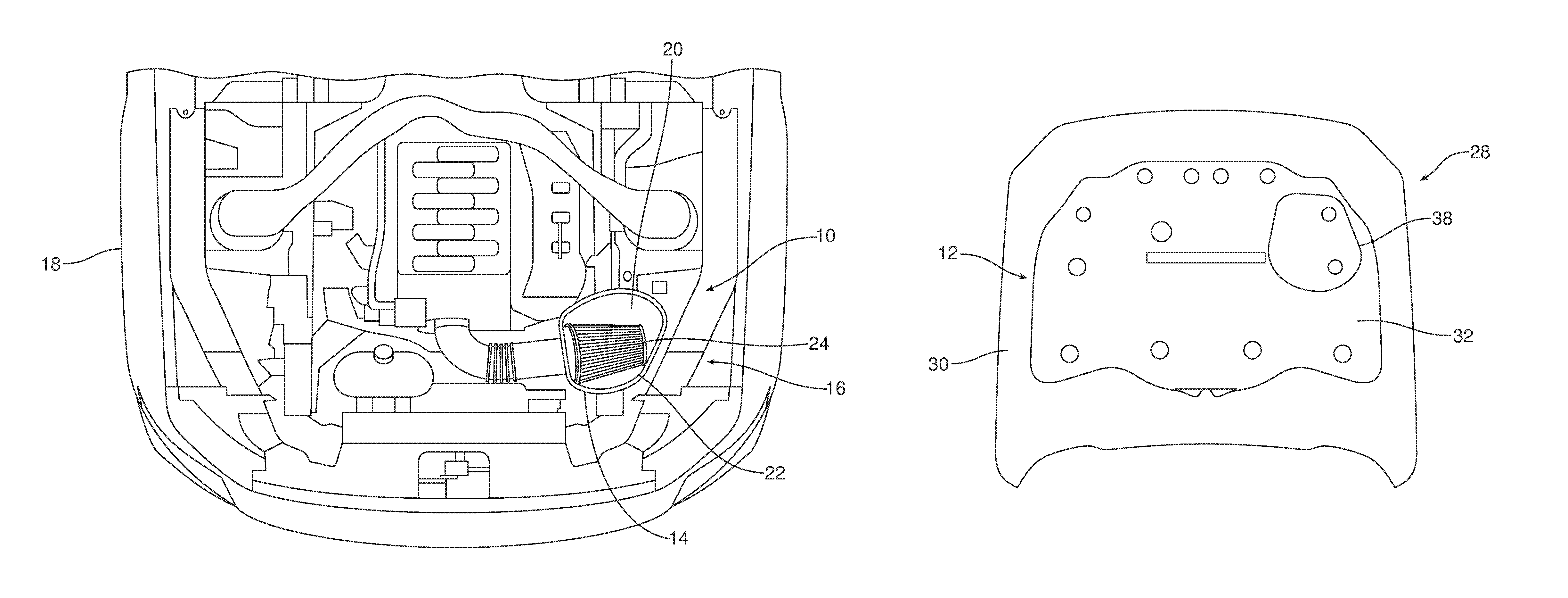
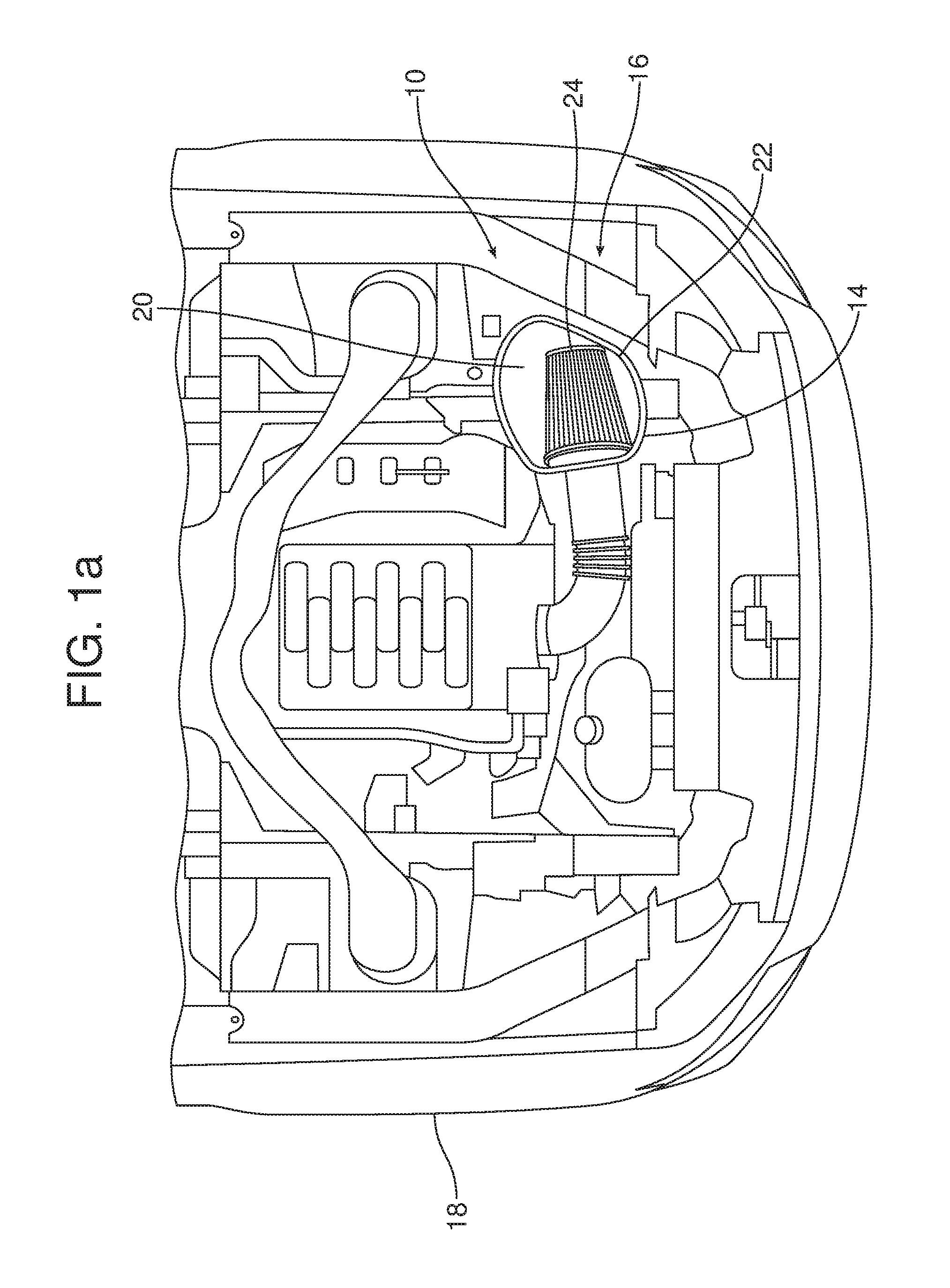
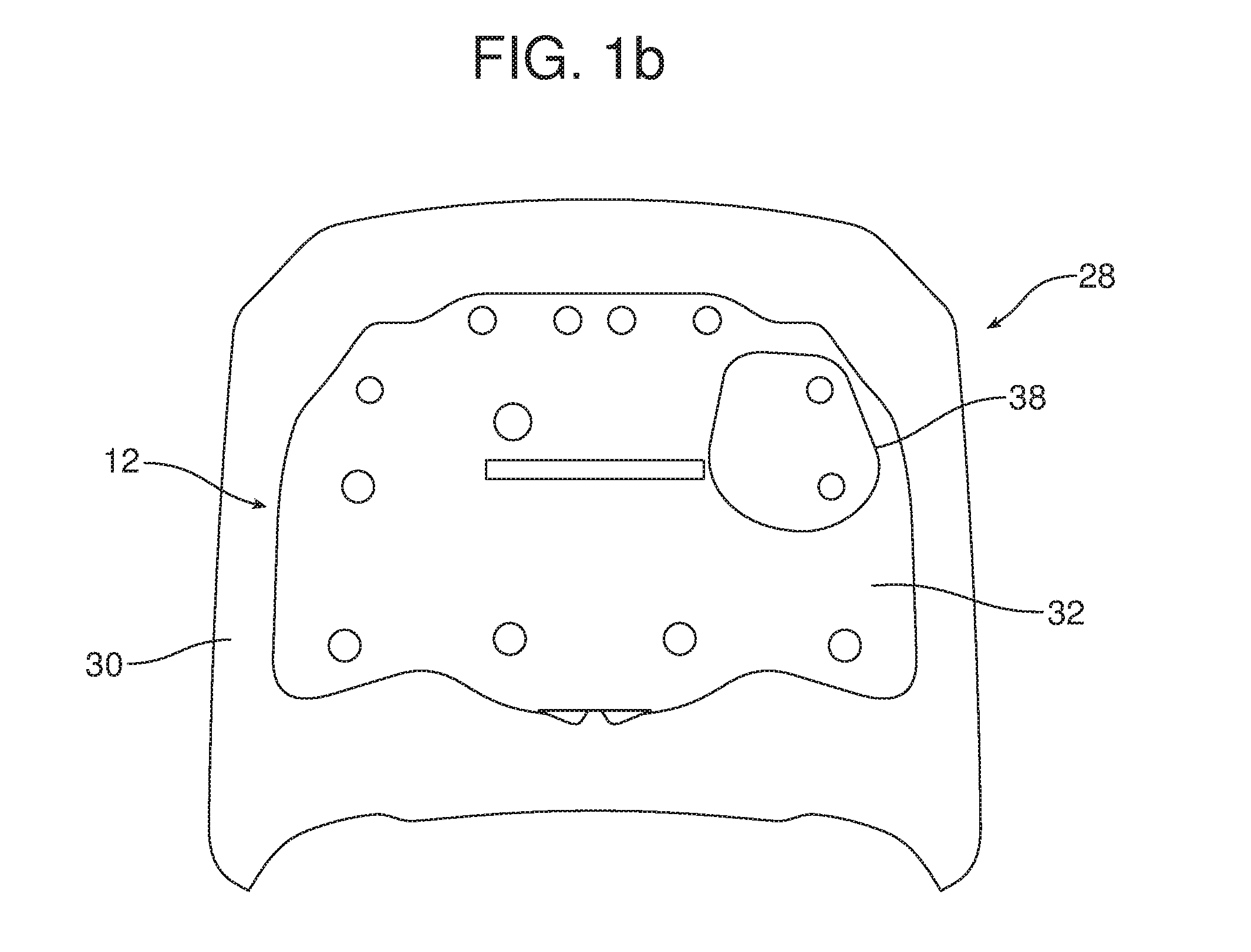
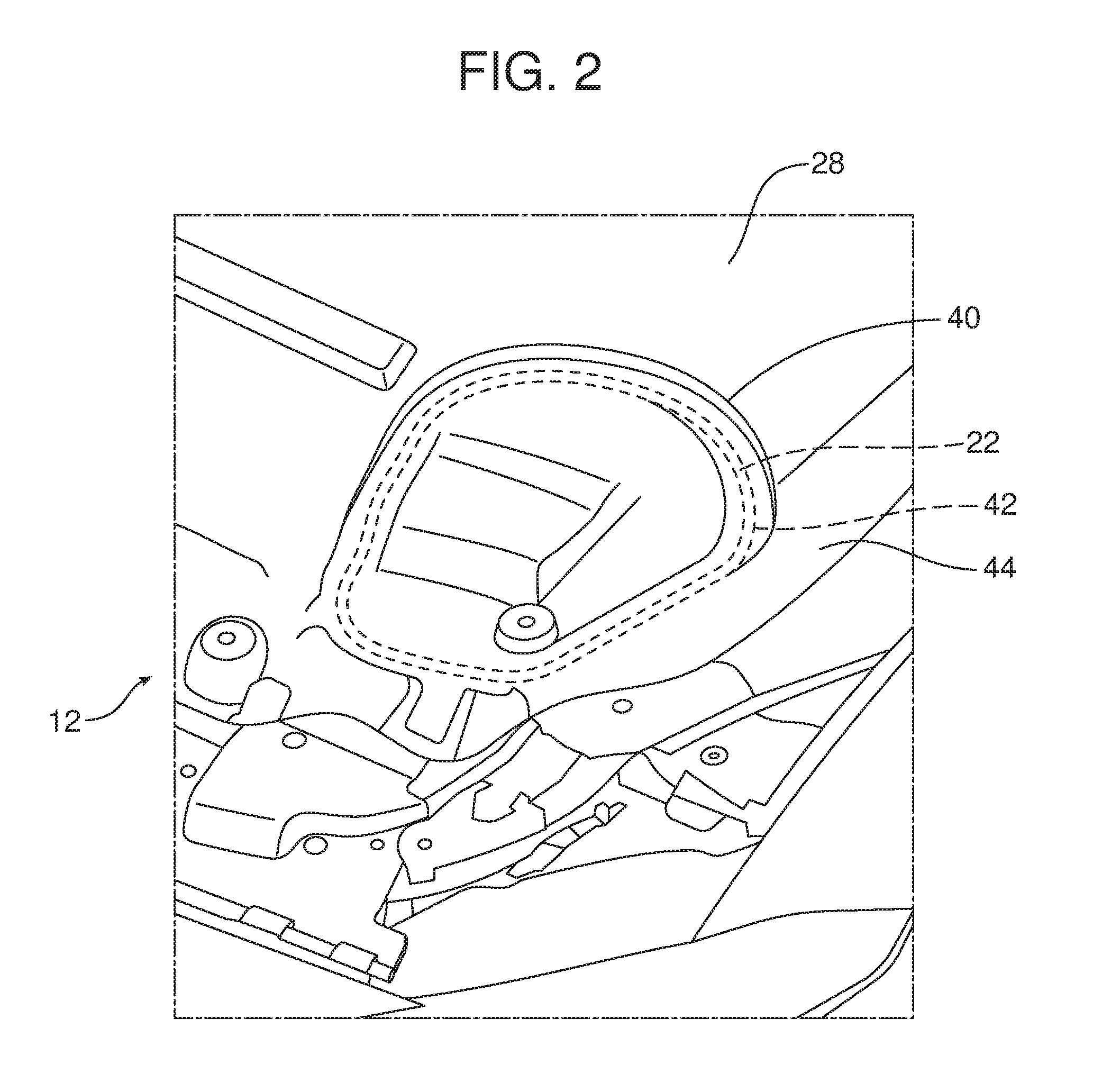
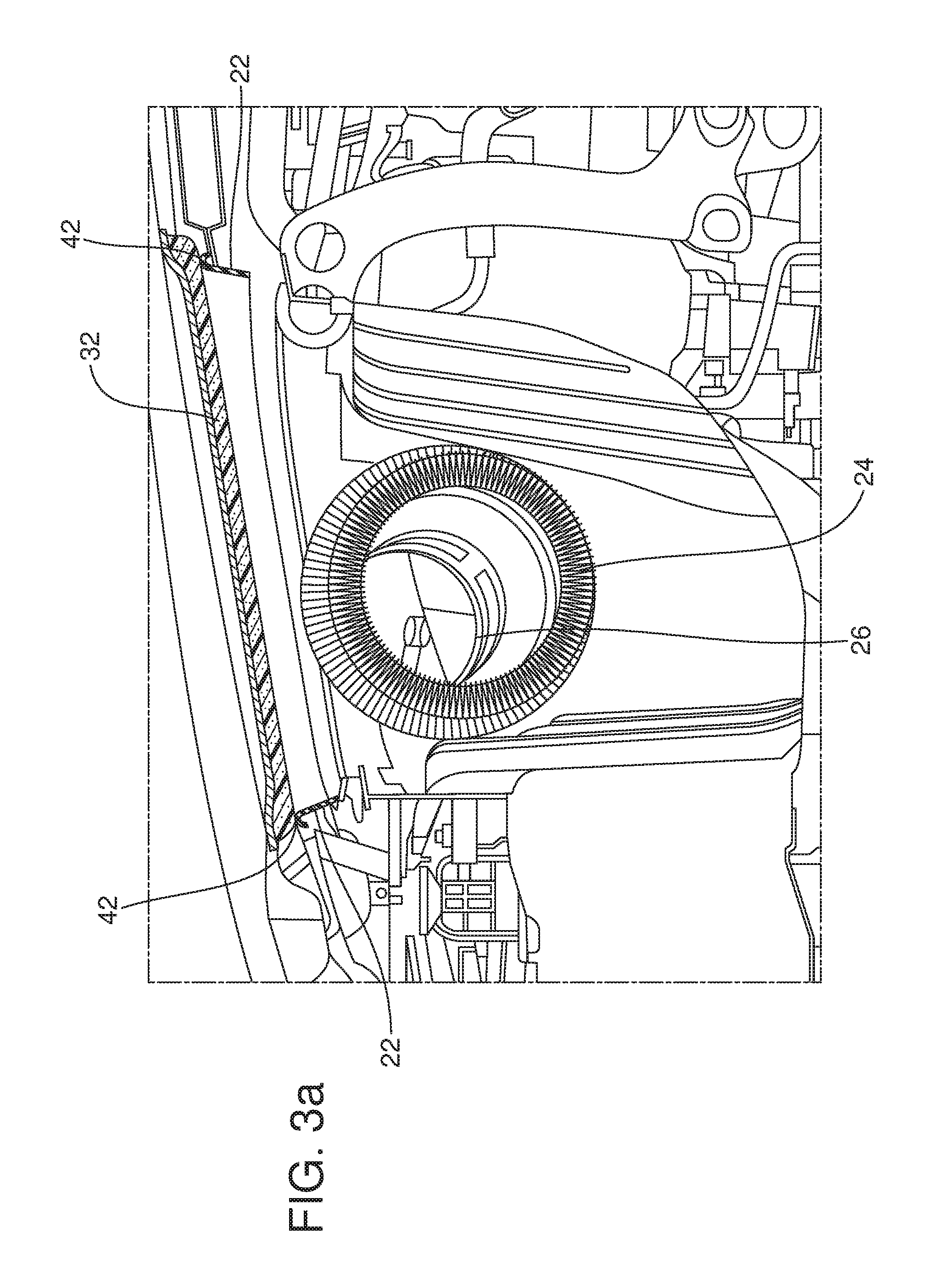

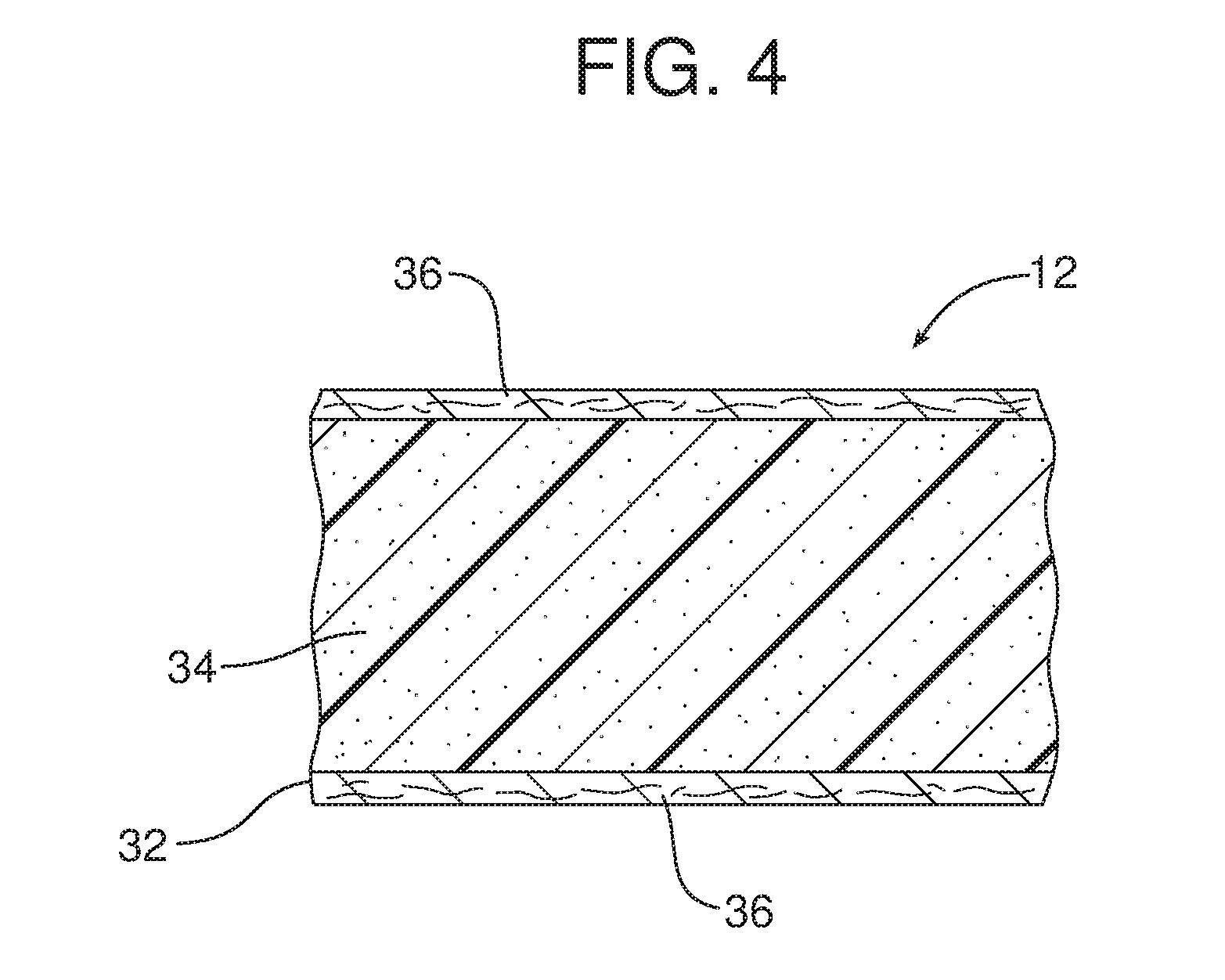
| United States Patent | 10,330,057 |
| Overgaard , et al. | June 25, 2019 |
Hood insulator having an integral air box closeout feature
Abstract
An engine air induction system includes an air box and a hood insulator. The air box has an open top and a perimeter seal extending continuously around the open top. The hood insulator has a body including an air box closeout feature providing a continuous interface with the perimeter seal when a hood assembly incorporating the hood insulator is in a closed position. A related method of sealing an open top on an air box of a motor vehicle is also disclosed.
| Inventors: | Overgaard; Neil Lawson (Ypsilanti, MI), Davies; Bryn Arthur (Novi, MI), Brown; Keith (Riverview, MI), Hagen; Martin (Troy, MI) | ||||||||||
|---|---|---|---|---|---|---|---|---|---|---|---|
| Applicant: |
|
||||||||||
| Assignee: | Ford Global Technologies, LLC
(Dearborn, MI) |
||||||||||
| Family ID: | 62843488 | ||||||||||
| Appl. No.: | 15/419,619 | ||||||||||
| Filed: | January 30, 2017 |
Prior Publication Data
| Document Identifier | Publication Date | |
|---|---|---|
| US 20180216584 A1 | Aug 2, 2018 | |
| Current U.S. Class: | 1/1 |
| Current CPC Class: | B60R 13/0838 (20130101); F02M 35/10242 (20130101); F02M 35/0204 (20130101); F02M 35/048 (20130101); B62D 25/105 (20130101); F02M 35/04 (20130101); B60K 13/06 (20130101); F02M 35/02416 (20130101); F02M 35/0201 (20130101); F02M 35/161 (20130101); B62D 25/12 (20130101); B60K 13/02 (20130101) |
| Current International Class: | F02M 35/02 (20060101); F02M 35/16 (20060101); B60K 13/06 (20060101); F02M 35/04 (20060101); B62D 25/10 (20060101); B60R 13/08 (20060101); F02M 35/024 (20060101); F02M 35/10 (20060101); B60K 13/02 (20060101); B62D 25/12 (20060101) |
References Cited [Referenced By]
U.S. Patent Documents
| 1883464 | October 1932 | Ball |
| 2701024 | February 1955 | Thomas |
| 3641746 | February 1972 | Smith |
| 4646864 | March 1987 | Racchi |
| 4831981 | May 1989 | Kitano |
| 4850444 | July 1989 | Bojanowski et al. |
| 5022479 | June 1991 | Kiser |
| 5558176 | September 1996 | Petersen et al. |
| 5950753 | September 1999 | Muldoon et al. |
| 6197403 | March 2001 | Brown et al. |
| 6514136 | February 2003 | Hanaya et al. |
| 7523798 | April 2009 | Muramatsu |
| 8181728 | May 2012 | Hartland |
| 9211791 | December 2015 | Laakso et al. |
| 9545844 | January 2017 | Forty |
| 2005/0217625 | October 2005 | Niaken et al. |
| 2010/0066127 | March 2010 | Goda et al. |
| 2013/0065499 | March 2013 | Patterson |
| 2016/0222927 | August 2016 | Kalauch |
| 4123947 | Jan 1993 | DE | |||
| 0419313 | Nov 1992 | EP | |||
| 0694426 | Jun 1999 | EP | |||
| 02158419 | Jun 1990 | JP | |||
| 10324267 | Dec 1998 | JP | |||
| 2014205412 | Oct 2014 | JP | |||
| 2013174662 | Nov 2013 | WO | |||
Other References
|
English Machine Translation of EP0419313B1. cited by applicant . English Machine Translation of DE4123947A1. cited by applicant . English Machine Translation of JP2014205412A. cited by applicant . English Machine Translation of JP02158419A. cited by applicant . English Machine Translation of JP10324267A. cited by applicant . Edgar, Julian; "Building and Testing an Airbox"; AutoSpeed; http://www.autospeed.com/cms/article.html?&title=Building-and-Testing-an-- Airbox&A=113248; Feb. 9, 2016; pp. 1-10. cited by applicant. |
Primary Examiner: Solis; Erick R
Attorney, Agent or Firm: Rogers; Jason Chea; Vichit King & Schickli, PLLC
Claims
What is claimed:
1. A hood insulator for sealing an open top on an air box of a motor vehicle, comprising: a body having an integral air box closeout feature, whereby the integral air box closeout feature closes the open top of the air box when a hood of the motor vehicle is closed to prevent air from passing through the open top of the air box.
2. The hood insulator of claim 1, wherein said integral air box closeout feature has a continuous profile.
3. The hood insulator of claim 2, wherein said integral air box closeout feature includes a continuous track forming an uninterrupted interface with a perimeter seal around the open top of the air box.
4. The hood insulator of claim 3, wherein said body includes a core enveloped in a cloth scrim.
5. The hood insulator of claim 4, wherein said core is made from a foam insulating material.
6. The hood insulator of claim 5, wherein said core is made from a fiberglass insulating material.
7. An engine air induction system, comprising: an air box having an open top and a perimeter seal extending continuously around said open top; and a hood insulator having a body including an air box closeout feature providing a continuous interface with said perimeter seal to close the open top of the air box.
8. The engine air induction system of claim 7, wherein said air box closeout feature is an integral part of said body.
9. The engine air induction system of claim 8, wherein said air box closeout feature has a continuous profile.
10. The engine air induction system of claim 9, wherein said air box closeout feature defines a continuous track forming an uninterrupted interface with said perimeter seal around said open top of said air box.
11. The engine air induction system of claim 10, wherein said body includes a core enveloped in a cloth scrim.
12. The engine air induction system of claim 11, wherein said core is made from a foam insulating material.
13. The engine air induction system of claim 12, wherein said core is made from a fiberglass insulating material.
14. The engine air induction system of claim 13, further including a replaceable air filter overlying an engine air induction inlet.
15. A method of sealing an open top on an air box of a motor vehicle, comprising: providing a hood assembly with a hood insulator including an integral air box closeout feature; and closing said hood assembly whereby said integral air box closeout feature seals the open top of the air box to prevent air from passing through the open top of the air box.
16. The method of claim 15, further including providing a perimeter seal on said air box surrounding said open top.
17. The method of claim 16, further including providing a continuous track on said integral air box closeout feature.
18. The method of claim 17, further including forming an uninterrupted interface between said integral air box closeout feature and said perimeter seal when said hood assembly is closed.
Description
TECHNICAL FIELD
This document relates generally to the motor vehicle equipment field and, more particularly, to a hood insulator incorporating an integral air box closeout feature as well as to an engine air induction system including an open top air box and that hood insulator with the air box closeout feature.
BACKGROUND
Some motor vehicles incorporate an engine air induction system with an open air box design in order to provide additional air flow to the engine and increase engine horsepower ratings. In order to achieve the additional airflow, the open air box is designed with an opening on the top of the air box adjacent to the vehicle's sheet metal inner hood panel. When the hood is opened, the top of the air box is also opened providing additional airflow to the engine. This is significant because when a motor vehicle is being rated for horsepower, the hood is open allowing additional airflow through the top of the open air box resulting in additional advertised horsepower of the engine.
Significantly the top of the open air box cannot remain open all the time when the vehicle is being driven as there is a risk for water and dirty air ingestion into the engine which could reduce engine performance or even damage the engine. Thus, the open top of the air box must be closed in some manner during driving conditions.
This document relates to a new and improved engine air induction system incorporating (a) an air box with an open top and a perimeter seal and (b) a hood insulator having a body including an air box closeout feature that provides a continuous interface with the perimeter seal to close the open top of the air box when the hood assembly of the motor vehicle is closed. A new and improved hood insulator with an integral air box closeout feature and a new and improved method of sealing an open top on an air box of a motor vehicle are also provided.
SUMMARY
In accordance with the purposes and benefits described herein, a hood insulator is provided. That hood insulator comprises a body having an integral air box closeout feature.
The integral air box closeout feature may have a continuous profile. Further, the integral air box closeout feature may define a continuous track forming an uninterrupted interface with the perimeter seal around an open top of an underlying air box.
The body of the hood insulator may include a core enveloped in a cloth scrim. That core may be made from a foam insulating material. In other embodiments, that core may be made from a fiberglass insulating material.
In accordance with an additional aspect, an engine air induction system is provided. That engine air induction system comprises (a) an air box having an open top and a perimeter seal extending continuously around the open top as well as (b) a hood insulator. The hood insulator has a body including an air box closeout feature that provides a continuous interface with the perimeter seal when the hood assembly is closed.
The air box closeout feature may be an integral part of the body. The air box closeout feature may have a continuous profile.
The air box closeout feature may define a continuous track forming an uninterrupted interface with the perimeter seal around the open top of the air box. The body may include a core enveloped in a cloth scrim. The core may be made from a foam insulating material or a fiberglass insulating material.
In accordance with yet another aspect, a method is provided for sealing an open top on an air box of a motor vehicle. That method comprises the steps of: providing a hood assembly with a hood insulator including an integral air box closeout feature and closing the hood assembly whereby the integral air box closeout feature seals the open top of the air box.
The method may further include the step of providing a perimeter seal on the air box surrounding the open top. In addition the method may include the step of including a continuous track on the integral air box closeout feature. Further, the method may include the step of forming an uninterrupted interface between the continuous track and the perimeter seal when the hood assembly is closed.
In the following description, there are shown and described several preferred embodiments of the hood insulator, the engine air induction system and the related method of sealing an open top on an air box of a motor vehicle. As it should be realized, the hood insulator, the engine air induction system and related method are capable of other, different embodiments and their several details are capable of modification in various, obvious aspects all without departing from the hood insulator, the engine air induction system and method as set forth and described in the following claims. Accordingly, the drawings and descriptions should be regarded as illustrative in nature and not as restrictive.
BRIEF DESCRIPTION OF THE DRAWING FIGURES
The accompanying drawing figures incorporated herein and forming a part of the specification, illustrate several aspects of the hood insulator, the engine air induction system and method of sealing an open top on an air box of a motor vehicle and together with the description serve to explain certain principles thereof.
FIG. 1a is a top plan view of an engine compartment of a motor vehicle illustrating the position of the air box of the engine air induction system including, the open top of the air box and the perimeter seal extending around the open top.
FIG. 1b is a bottom plan view of the hood assembly of the motor vehicle including the hood insulator with the integral air box closeout feature.
FIG. 2 is a detailed perspective view from above illustrating the B face of the hood insulator including the continuous track that forms the uninterrupted interface (illustrated in phantom line) with the underlying perimeter seal of the air box when the hood assembly is closed.
FIG. 3a is a cross sectional view of the engine air induction system illustrating how the air box closeout feature on the hood insulator forms a continuous interface with the perimeter seal extending continuously around the open top of the air box.
FIG. 3b is a view similar to FIG. 3a but taken along the X axis of the motor vehicle.
FIG. 4 is a cross sectional view of the hood insulator 12.
Reference will now be made in detail to the present preferred embodiments of the hood insulator and the engine air induction system, examples of which are illustrated in the accompanying drawing figures.
DETAILED DESCRIPTION
Reference is now made to FIGS. 1a, 1b, 2, 3a, 3b and 4 illustrating the new and improved engine air induction system 10 which includes the novel hood insulator 12. As illustrated in FIG. 1a, the engine air induction system 10 includes an air box 14 situated in the engine compartment 16 of a motor vehicle 18. The air box 14 includes an open top 20 and a perimeter seal 22 extending continuously around the open top. The perimeter seal 22 may be made from a flexible polymer material of a type known in the art. A replaceable air filter 24 is received in the air box 14 and overlies or covers the engine air induction inlet 26 (see also FIGS. 3a and 3b).
FIG. 1a illustrates a hood assembly 28 comprising a sheet metal hood 30 and the hood insulator 12 attached to the underside of the sheet metal hood by retention clips or other means (not shown). As illustrated in FIG. 4, that hood insulator 12 has a body 32 including a core 34 enveloped in a cloth scrim 36. The core 34 may be made from a foam insulating material or a fiberglass insulating material of a type known in the art.
As best illustrated in FIGS. 1b, 2, 3a and 3b, the body 28 of the hood insulator 12 includes an integral air box closeout feature 38. In the illustrated embodiment, the integral air box closeout feature 38 has a continuous profile. In some embodiments, that profile may also be raised. Further, the integral air box closeout feature 38 includes a continuous track 40 that forms an uninterrupted interface 42 with the perimeter seal 22 of the air box 14 around the open top 20 of the underlying air box when the hood assembly 28 is seated in the closed position. This continuous sealing prevents ingestion of water and dirty air through the open top 20 while the motor vehicle 18 is being driven.
Consistent with the above description, a method is provided of sealing the open top 20 on an air box 14 of a motor vehicle 18. That method includes the steps of: (a) providing a hood assembly 28 with a hood insulator 12 including an integral air box closeout feature 38 and closing the hood assembly whereby the integral air box closeout feature seals the open top of the air box. See FIGS. 3a and 3b.
The method may further include the step of providing the perimeter seal 22 on the air box 14 surrounding the open top 20. Further, the method may include the step of including a continuous track 40 on the integral air box closeout feature 38. As best illustrated in FIG. 2, that continuous track 40 is provided on the B surface 44 of the hood insulator body 32. When the hood assembly 28 is closed and the integral air box closeout feature 38 engages with and forms the continuous interface 42 with the perimeter seal 22, the continuous track 40 butts against the inner surface of the sheet metal hood 30 providing a back stop to ensure that the necessary pressure is provided at the continuous interface for a seal of high integrity. Thus, it should be appreciated that the method also includes the step of forming the uninterrupted interface 42 between the integral air box closeout feature 38 and the perimeter seal 22 when the hood assembly 28 is closed.
The foregoing has been presented for purposes of illustration and description. It is not intended to be exhaustive or to limit the embodiments to the precise form disclosed. Obvious modifications and variations are possible in light of the above teachings. All such modifications and variations are within the scope of the appended claims when interpreted in accordance with the breadth to which they are fairly, legally and equitably entitled.
* * * * *
References
D00000

D00001

D00002

D00003

D00004

D00005

D00006

XML
uspto.report is an independent third-party trademark research tool that is not affiliated, endorsed, or sponsored by the United States Patent and Trademark Office (USPTO) or any other governmental organization. The information provided by uspto.report is based on publicly available data at the time of writing and is intended for informational purposes only.
While we strive to provide accurate and up-to-date information, we do not guarantee the accuracy, completeness, reliability, or suitability of the information displayed on this site. The use of this site is at your own risk. Any reliance you place on such information is therefore strictly at your own risk.
All official trademark data, including owner information, should be verified by visiting the official USPTO website at www.uspto.gov. This site is not intended to replace professional legal advice and should not be used as a substitute for consulting with a legal professional who is knowledgeable about trademark law.